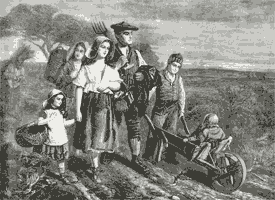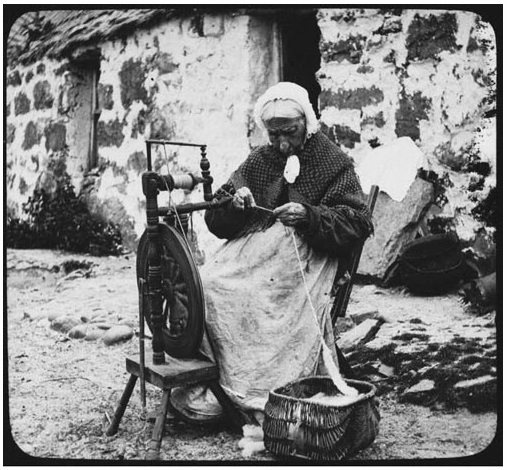
Image from www.old-print.com

 In the late 18th and early 19th centuries, Scotland was primarily an agricultural society. Not surprisingly, most of our ancestors worked the farms.
In the late 18th and early 19th centuries, Scotland was primarily an agricultural society. Not surprisingly, most of our ancestors worked the farms.
Land was owned by a small number of people; frequently a parish had only a handful of landlords.1 There were six landlords in Old Cumnock parish (covering 20 square miles), home of the McCrie family; nine in Ochiltree (24 sq mi), home of the Brown family; fourteen in Glassary (150 sq mi), home of the Campbell family; and four in Craignish (22 sq mi), home of the Livingston family.
The landlords rented out their land to tenant farmers,2 who either had tenancy for a set number of years or who could be evicted at whim, such as during the "clearances" in the highlands and later the lowlands.
In turn, the tenant farmers hired agricultural laborers to help work the land and sometimes servants to help with domestic duties. The tenants generally (but not always) lived on the farm, as did the laborers.
Some of our ancestors were tenants, some were agricultural laborers. One owned a small farm. The table below shows how our fathers earned their living on the land.
Farm women, too, made a substantial economic contribution to the family. In the mid-eighteenth century approximately eighty percent of adult women in Scotland were involved in spinning,3 many producing yarn for sale. Since croft (small farm) houses typically didn't include windows in the Highlands, the women sat outside at the spinning wheel, making the most of the light. In the photo at right, from the Scottish National Museum of Rural Life, an elderly woman wears a traditional mutch (head cap) and shawl while engaged at her spinning wheel.
| Name (birth-death) | Area | Farm | Occupation | Year |
| John Campbell: Sarah Livingston's father (1796-1854) | Argyl: Glassary | Upper Rudle | Agricultural labourer | 1841 |
| John Campbell (1796-1854) | Argyl: Kilmartin | Auchachrom | Portioner (owner) of a small farm | 1851 |
| Alexander McNair: John Livingston's uncle (1799-1885) | Argyll: Kilmartin | Tibertich | Farmer (tenant) employing 3 labourers | 1851 |
| Alexander McNair (1799-1885) | Argyll: Kilmartin | Craigenterve Beag | Farmer (tenant) 150 acres, 16 arable | 1871 |
| Hugh McCrie: Wm's father (abt 1779-1841) | Ayr: Old Cumnock | Glaisnock Lots | Agricultural labourer | 1841 |
| Hugh McCrie: Wm's brother (1808-1884) | Ayr: Old Cumnock | Glaisnock Lots | Agricultural labourer | 1841 |
| Hugh McCrie (1808-1884) | Ayr: Old Cumnock | Roadside Farm | Labourer | 1851 |
| Hugh McCrie (1808-1884) | Ayr: Old Cumnock | Roadside Farm | Game Hird (herder) | 1861 |
| Hugh McCrie (1808-1884) | Ayr: Old Cumnock | Roadside Farm | Game Keeper | 1881 |
| John Brown: Wm McCrie's uncle (1776-aft 1861) | Ayr: Ochiltree | Burnockston | Farmer (tenant) w/two servants | 1841 |
| John Brown (1776-aft 1861) | Ayr: Ochiltree | Burnockston | Farmer (tenant) of 120 acres | 1851 |
Footnotes:
1 The number of landlords in Scottish parishes is from the 1834-45 Statistical Accounts of Scotland at http://stat-acc-scot.edina.ac.uk/sas/sas.asp?account=2&accountrec=11692&action=publicdisplay&naecache=7&root_start=0&session-id=08ec52728510c78369e18aae53141482&treecloseall=1&treeopen=1834_45&treeupdatebyuser=1#1834_45
2 Tenant farmer system in Great Britain from the Wikipedia "Tenant Farmer" page: http://en.wikipedia.org/wiki/Tenant_farmer#Scotland
3 The widespread practise of spinning amoung rural Scottish women is from the Scottish National Museum at http://www.flickr.com/photos/nationalmuseumsscotland/5709173089/in/photostream/